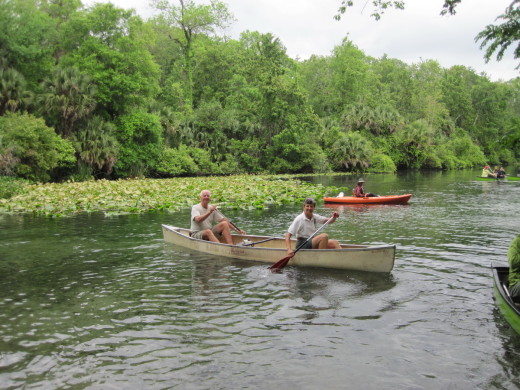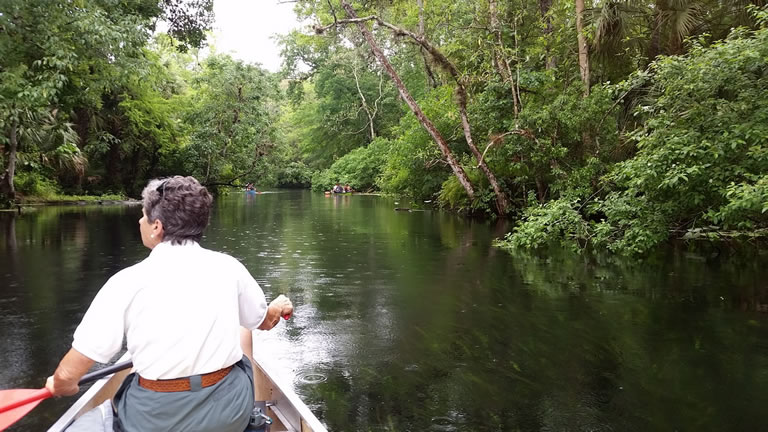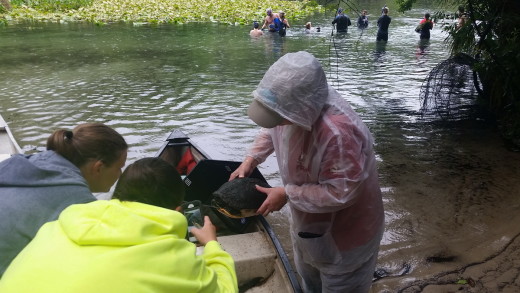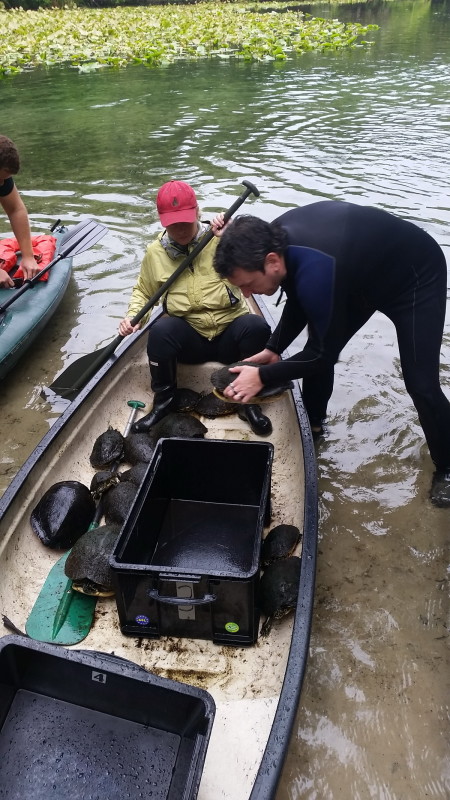Even though most of our reptile work centers around snakes, other reptiles interest us as well. Recently, we were invited to join a long term population study of freshwater turtles at Wekiva Springs State Park near Orlando, Florida, to help collect turtles for a survey. Warm drizzling rain accompanied us on our drive to the Park and continued as we met with Virginia Oros, Wekiva Wild and Scenic River Ambassador with the Florida Department of Environmental Protection, to learn the objectives of this research and the logistics of gathering the turtles.
Getting Instructions
Virginia had arranged in advance with concessions at the Park for a canoe we could use to join others along the run from Wekiva Springs. After some brief instructions, we set off paddling with the current along with six other canoes and a kayak. Some canoes carried divers who were offloaded at the one mile marker. Donning masks and flippers, the divers slipped from the canoes, positioned their snorkels, and headed back upstream, capturing any turtles they could locate.

The mile-long stretch had previously been divided into 10 sections, and most canoes carried large plastic boxes, each numbered with one section. Turtles were deposited into boxes that corresponded to their capture area so they could be returned to their original habitat when researchers finished weighing, measuring, inspecting, and pit tagging them.
Indicator
This was the 16th year of a 25-year project monitoring turtle health and numbers. “If the population drops,” says Virginia, “this could be an indicator of declining water quality and ecosystem.”
Helping Divers
Many of the other volunteers and researchers had participated several years; some have joined in every year. Because we were mainly along to observe, we did not carry divers or boxes in our canoe, but rather remained available to assist divers if and when necessary.
Rain intensified as we slowly paddled upstream, following a couple divers who poked through lily pads, cypress, and other aquatic vegetation, sometimes surfacing with a turtle in one hand and occasionally a turtle in each hand. If we were the only boat nearby, they delivered their captives to us, and we paddled to whichever canoe carried the box with their location number.
Different Sizes
Turtles ranged from babies the size of walnuts to adult loggerhead musk turtles the size of teacups, cooters the size of dinner plates, and snappers the size of large platters. Many of the turtles handed to us by divers were the dinner plate size and may have weighed 15 pounds or more. “I could feel the canoe tip when you lifted one into it,” Chuck later told me. Besides their weight, slimy algae coated their carapaces, making it tricky to grasp them and haul them onboard.
When divers finished with the numbered areas, they ended up in the lagoon near the launch site. Here, with most of the other canoes already beached with their haul, we circled divers as they continued to locate more turtles and hand them to us. The smaller loggerheads arrived with mouths agape, ready to clamp onto anything in their path. Larger turtles, in their attempt to escape, scratched at our hands with their claws. “Ever since my first experience with this project when one scraped the palm of my hand,” said Virginia, “I’ve worn gloves to pick them up!”
Great Experience
Researchers removed the turtles from the boxes and canoes to begin their work. Although our participation was minimal, our experience was outstanding!




Betty, I really enjoyed this article and know that was a fun day!
It WAS fun and we learned quite a bit as well. A great combination! We were shocked by the high number of turtles that were captured, tagged and released!
Sounds like a very interesting day. Would loved to have gone along. As I have kayaked over the years, I’ve often wondered where they swam off to when we would go back in the kayaks.